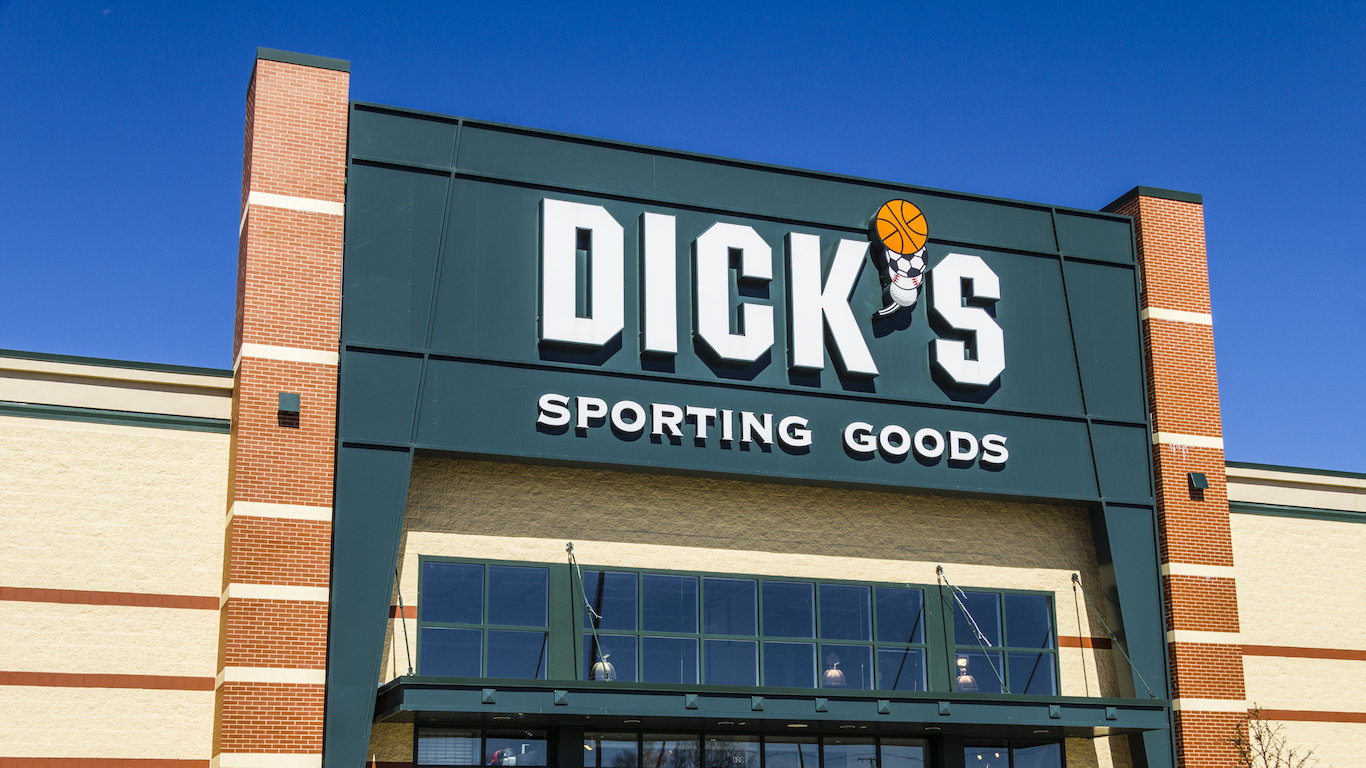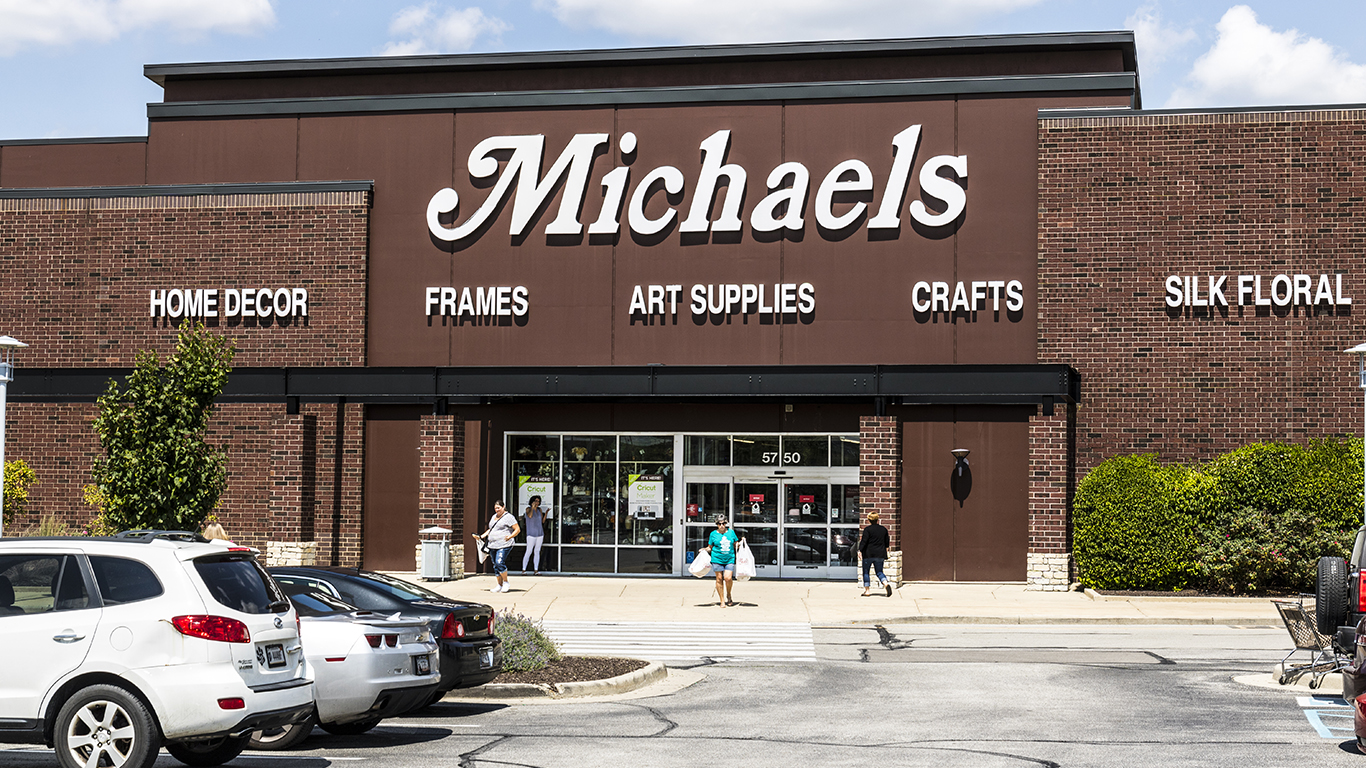Special Report
Retailers Hiring the Most for the Holidays
Published:
Last Updated:

Meeting consumer demand during the final three months of the year is no small task. To handle the increased load, major retailers nationwide hire tens of thousands of temporary workers during the busy shopping season. 2017 is no exception.
24/7 Wall St. reviewed 13 companies that are hiring seasonal employees this holiday season. Each company on this list is adding thousands of seasonal workers to its payroll — in some cases the number of seasonal workers greatly outnumbers a retailer’s average year-round employee headcount.
Click here to see the retailers hiring the most workers for the holidays.
Click here to see our detailed findings and methodology.

13. Omaha Steaks
> 2017 seasonal hires: 4,000
> Total U.S. employees: 1,800
> Store count: 68 (U.S.)
> Annual revenue: $450 million
Omaha Steaks — a distributor of steaks and other foods based in Omaha, Nebraska — is one of several telemarketing and retail companies adding workers during the holidays. The company reported a record number of orders last holiday season — and this year, in anticipation of the holiday rush, Omaha Steaks is hiring some 4,000 temporary workers, 30% more than last year. Seasonal jobs with the company will range from call center workers to forklift operators — both full- and part-time.
[in-text-ad]

12. Dick’s Sporting Goods
> 2017 seasonal hires: 7,000
> Total U.S. employees: 37,600
> Store count: 797 (U.S.)
> Annual revenue: $7.9 billion
Dick’s Sporting Goods plans to hire an additional 7,000 workers for the holiday season at 16 select locations across the country. The company currently employs approximately 40,500 workers throughout 710 U.S. locations. The fourth quarter typically represents the highest sales quarter for the footwear and sporting gear and apparel store. Sales receive a boost both from the holiday shopping season and from the increased sales of cold weather sporting goods and apparel. In the fourth quarter of 2016, Dick’s reported a total of $2.5 billion in revenue, nearly half the $5.4 billion in revenue the store reported in the three quarters preceding it.

11. 1-800-Flowers
> 2017 seasonal hires: 8,000
> Total U.S. employees: 4,633
> Store count: 125 (U.S.)
> Annual revenue: $1.2 billion
1-800-Flowers announced in September its plan to hire approximately 8,000 associates in preparation for the coming holiday shopping season. The company’s workforce, which currently consists of 4,633 employees, will nearly triple in size. Demand for the 1-800-Flowers products and its brands — which include Harry & David, The Popcorn Factory, Wolferman’s, and FruitBouquets.com — is largely seasonal, and the period between Thanksgiving and Christmas accounts for 50% of the company’s annual revenue.

10. Bon-Ton Stores
> 2017 seasonal hires: 10,000
> Total U.S. employees: 24,000
> Store count: 262 (U.S.)
> Annual revenue: $525.5 billion
Bon-Ton Stores, which operates a number of brick-and-mortar retail brands, including Bon-Ton, Boston Store, Bergner’s, and Carson’s, is planning to add some 10,000 temporary workers to handle the anticipated spike in sales around the holiday season. The company has some 262 locations and five distribution centers nationwide, employing some 24,000 associates. The seasonal hires will work to meet demand from customers both online and in stores.
[in-text-ad-2]

9. Toys R Us
> 2017 seasonal hires: 12,000
> Total U.S. employees: 36,000
> Store count: 879 (U.S.)
> Annual revenue: $11.5 billion
Despite filing for bankruptcy in September 2017, Toys R Us announced it will be hiring additional help in preparation for the holiday shopping season. Specifically, the company plans to hire 12,000 additional employees to work in its in New York City, Los Angeles, Philadelphia, Chicago, and Boston locations as well as in a warehousing facility in Groveport, Ohio. The company will likely hire thousands more to work in its other locations nationwide. In the 2016 holiday season, Toys R Us hired 43,000 temporary workers in stores around the world. Consumer demand for toys is largely seasonal, and winter is the company’s busiest season by far. Toys R Us typically incurs net losses during the first three quarters of the year, with the fourth quarter accounting for 40% of its annual revenue and the entirety of its profitability.

8. Michael’s
> 2017 seasonal hires: 15,000
> Total U.S. employees: 50,000
> Store count: 1,222 (U.S.)
> Annual revenue: $5.2 billion
Michael’s is a brick-and-mortar retailer that sells materials for arts and crafts, seasonal decor, framing, and paper crafting. As is the case with many American retailers, the holiday season is a critical time for Michael’s. Historically, the company’s fourth quarter, which includes the holidays, accounts for an average 34% of net sales and 45% of operating income. This year, the company plans to hire 15,000 seasonal workers to meet the increased demand during the holiday sales season. Last year, more than half of the company’s holiday workers became regular workers.
[in-text-ad]

7. Radial
> 2017 seasonal hires: 27,000
> Total U.S. employees: 7,000
> Store count: 14 (U.S.)
> Annual revenue: $1 billion
The least recognizable company on this list, Radial works with other companies to manage and route orders, process payments, and provide analytics services. Among the company’s clients are several retailers with e-commerce divisions, including DSW Inc., GameStop Corp., and Shoe Carnival Inc. As orders at these companies increase during the holiday season, business at Radial spikes as well. Citing an anticipated record year for holiday e-commerce sales, Radial is hiring some 27,000 seasonal workers — nearly quadrupling the size of the company’s normal workforce — to handle the influx.
Radial operates 25 distribution centers and six customer care centers in the United States, Canada, and Europe.

6. JCPenney
> 2017 seasonal hires: 40,000
> Total U.S. employees: 106,000
> Store count: 1,013 (U.S.)
> Annual revenue: $12.5 billion
In September 2017, department store JCPenney announced it will hire an additional 40,000 employees for the holiday shopping season, the same amount as last year. Like many large retailers, JC Penney had a relatively disappointing holiday season in 2016, with same-store sales for November and December falling 0.8% year-over-year. The retail sector is projected to perform better this season, however. Information consultancy Kantar projects a 2.5% sales increase at brick-and-mortar apparel and home goods retailers during the holidays this year.

5. FedEx
> 2017 seasonal hires: 50,000
> Total U.S. employees: 400,000
> Store count: 9,125 (worldwide)
> Annual revenue: $60.3 billion
The rise of e-commerce has had ripple effects throughout multiple industries. FedEx’s need for temporary workers during the holiday season is one example. Due in large part to people doing their holiday shopping online, the parcel delivery company is hiring some 50,000 seasonal workers and offering additional hours to its current employees during the holiday shopping season.
For Americans shipping packages over the holidays, FedEx operates more than 1,800 customer-facing centers.
[in-text-ad-2]

4. Macy’s
> 2017 seasonal hires: 80,000
> Total U.S. employees: 148,300
> Store count: 829 (U.S.)
> Annual revenue: $25.8 billion
Macy’s is hiring 80,000 seasonal employees to help out during the busy holiday sales season. Some 18,000 temporary workers will work in distribution centers for orders placed online — 3,000 more than in 2016. The company will hire 1,000 seasonal workers to interact with customers online and over the phone, and it will hire another 1,000 to staff the Macy’s Thanksgiving Day Parade and work in so called Santaland locations in stores nationwide.
Like many retail giants, Macy’s business is taking a hit from the rise of e-commerce. The company operates some 829 Macy’s, Bloomingdale’s, and Bluemercury stores nationwide, down from 868 in 2015.

3. UPS
> 2017 seasonal hires: 95,000
> Total U.S. employees: 434,000
> Store count: 4,889 (U.S. and Canada)
> Annual revenue: $60.9 billion
UPS will hire an additional 95,000 workers for the holiday season. The holidays are the busiest time for UPS, with some packages shipped in late November and December requiring an additional day in transit due to the additional package volumes. While UPS shipped an average of 15.2 million packages a day in the first three quarters of 2016, the company shipped an average of 19.6 million packages a day in the fourth quarter. The average revenue per package, however, fell from $10.48 to $9.85 during the fourth quarter. This year, UPS will charge an additional 27 cents on all ground shipments sent during the periods of November 19 to December 2, and December 17 to December 23 — some of the busiest shipping days of the year.
[in-text-ad]

2. Target
> 2017 seasonal hires: 104,500
> Total U.S. employees: 323,000
> Store count: 1,802 (U.S.)
> Annual revenue: $69.5 billion
Target is hiring some 100,000 temporary workers for its customer-facing department stores this holiday season. The retail giant, which also sells products to online shoppers, will hire an additional 4,500 workers to staff its distribution centers during the busy season. Like many retailers on this list, Target’s fourth quarter, which includes the holiday season, comprises a large share of the company’s annual revenue.
Currently, the company employs 323,000 regular workers. Last year, employment peaked at 373,000 workers during the holiday season.

1. Amazon
> 2017 seasonal hires: 120,000
> Total U.S. employees: 341,000
> Store count: 42 (U.S.)
> Annual revenue: $136.0 billion
To accommodate the increased demand during the holiday season, Amazon plans to hire 120,000 additional workers, the most of any company. Amazon also hired 120,000 workers for the 2016 holiday season, of which thousands transitioned into regular, full-time roles at Amazon. The e-commerce giant expects to do the same this year. Most of the temporary positions will be at Amazon’s customer service centers in 33 states across the country. Amazon is growing rapidly, and the company’s hiring spree is not limited just to the holidays. Amazon has hired 200,000 employees so far this year, and it is currently scouting locations for a second headquarters — where it will need as many as 50,000 additional workers.
Detailed Findings & Methodology
For many of the biggest names in American retail, the holiday shopping season is a critical time, accounting for a disproportionately large share of their total annual sales. For arts and crafts and holiday decoration retailer, Michael’s, the fourth quarter — which includes the holidays — accounts for 45% of the company’s operating income. For children’s store Toys R Us, the fourth quarter accounts for 40% of its annual revenue and the entirety of its profitability.
The holiday season includes two of the biggest shopping days of the year: Black Friday and Cyber Monday — the former a boon for brick-and-mortar retailers, and the latter for online retailers. Though Americans are still projected to do most of their shopping in physical stores and shopping malls nationwide, online stores are increasingly capture a larger market share.
E-commerce accounted for 10.6% of total retail sales in the 2016 holiday season. This year, it is projected to account for 12.0%.
The growing popularity of online shopping is also apparent in seasonal hiring patterns. No company is taking on more seasonal workers than e-commerce giant Amazon. The company recently announced plans to hire 120,000 additional workers to accommodate customers during the holiday months. The company transitioned thousands of seasonal employees into regular, full-time roles last year, and it anticipates this year will be no different.
Even traditional brick-and-mortar retailers are hiring thousands of temporary workers to meet demand for online orders exclusively. Macy’s, for example, is adding some 18,000 temporary workers to work in its distribution centers for orders placed online — 3,000 more than in 2016.
To determine the retailers hiring the most workers for the holidays, 24/7 Wall St. reviewed press releases related to hiring plans for the 2017 holiday season and related media coverage. Only companies with published figures related to the number of additional employees they plan to hire were included. Store counts include subsidiaries and are for the United States when available, and are noted if otherwise.
Let’s face it: If your money is just sitting in a checking account, you’re losing value every single day. With most checking accounts offering little to no interest, the cash you worked so hard to save is gradually being eroded by inflation.
However, by moving that money into a high-yield savings account, you can put your cash to work, growing steadily with little to no effort on your part. In just a few clicks, you can set up a high-yield savings account and start earning interest immediately.
There are plenty of reputable banks and online platforms that offer competitive rates, and many of them come with zero fees and no minimum balance requirements. Click here to see if you’re earning the best possible rate on your money!
Thank you for reading! Have some feedback for us?
Contact the 24/7 Wall St. editorial team.